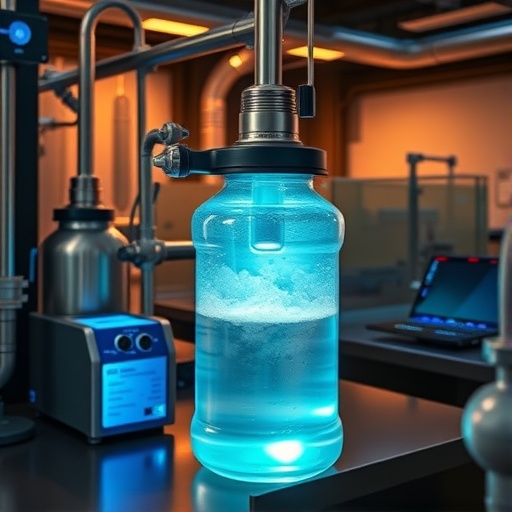In a bold move toward enhancing waste treatment processes, researchers have made significant advancements in the field of environmental science by exploring innovative thermal pretreatment methods. Their findings, outlined in a recent article, reveal that electromagnetic-based thermal pretreatments can substantially elevate the efficiency of pharmaceutical removal during advanced anaerobic sludge digestion. This breakthrough has far-reaching implications for the management of pharmaceutical pollutants in wastewater systems, which have become a growing concern due to their adverse effects on ecosystems and human health.
The urgency of tackling pharmaceutical pollution cannot be overstated. Residues from pharmaceuticals frequently enter wastewater systems, leading to potential contamination of drinking water and adverse ecological impacts. Conventional wastewater treatment methods often fall short in effectively removing these persistent organic contaminants. As researchers seek out innovative solutions, electromagnetic-based thermal pretreatments present a promising avenue worth investigating.
The study led by Kor-Bicakci, Johnson, and Eskicioglu dives deep into various pretreatment methods, scrutinizing their efficiency and potential application in real-world scenarios. Employing electromagnetic processes, the researchers aimed to enhance the thermal breakdown of complex pharmaceutical compounds, making them easier to digest during the anaerobic digestion process. This promising technique could reshape conventional treatment frameworks by increasing the degradation rates of pharmaceuticals in wastewater.
An essential aspect of this research lies in the characterization of the electromagnetic-based thermal pretreatments. Utilizing specific frequencies and intensities, these methods harness electromagnetic energy to generate heat, which accelerates the breakdown of pharmaceutical compounds. This innovative approach not only targets the contaminants more directly but also significantly reduces processing times, a critical factor in enhancing overall efficiency in waste treatment systems.
Experimental results revealed that the implementation of electromagnetic-based thermal pretreatments resulted in notable improvements in the removal rates of selected pharmaceuticals. The findings highlight how variations in treatment conditions, such as temperature and exposure duration, can lead to substantial differences in the effectiveness of pharmaceutical degradation. These results point toward a vast potential for optimizing treatment systems to tailor approaches that address specific contaminants more effectively.
In addition to enhancing pharmaceutical removal, the article emphasizes the potential environmental benefits associated with such advancements. By improving the efficiency of sludge digestion, researchers could contribute to reducing the energy requirements of treatment plants, leading to lower operational costs and a smaller carbon footprint. This presents a dual benefit: enhanced environmental sustainability alongside economic efficiency.
Furthermore, as regulatory bodies worldwide increase scrutiny over wastewater treatment practices, the need for robust methodologies to ensure the safety of aquatic environments and public health becomes paramount. The implications of these advancements are significant in meeting increasingly stringent regulations surrounding pollutants. By adopting innovative techniques, treatment facilities can not only comply with regulations but also promote a healthier ecosystem.
Moreover, the study’s authors advocate for broader adoption of these techniques across wastewater treatment facilities. While the laboratory results are promising, practical implementations remain crucial for realizing the full potential of electromagnetic-based thermal pretreatments. Pilot programs and partnerships with local treatment plants could provide valuable insights into the scalability and adaptability of the process in diverse operating conditions.
Despite the exciting prospects, the researchers also recognize the challenges ahead. Integrating new technologies within existing treatment frameworks requires careful consideration of economics, operational logistics, and staff training. As facilities transition to adopting these advanced methods, comprehensive assessments will ensure that they yield the intended benefits without unforeseen complications.
Collaboration across disciplines will play a vital role in overcoming barriers to implementation. Engaging engineers, environmental scientists, and policy-makers will be essential in shaping future research agendas that prioritize innovative waste treatment solutions. The interdisciplinary nature of environmental challenges demands a concerted effort to accelerate the development and adoption of effective technologies.
In conclusion, the study presents a landmark advancement in the removal of pharmaceuticals from wastewater through electromagnetic-based thermal pretreatments. As researchers continue to explore and refine these methods, the potential to transform wastewater treatment practices grows stronger. With implications extending beyond enhanced treatment efficiency, this research stands to contribute significantly to public health safeguards and ecological protection.
As society grapples with the persistent issue of pharmaceutical pollutants, groundbreaking research like this will be instrumental in steering efforts toward sustainable solutions. The journey from laboratory findings to real-world applications promises to be as challenging as it is necessary; however, the prospects of improving wastewater treatment efficiency with electromagnetic-based thermal pretreatments offer a path filled with hope.
The future of wastewater treatment could very well be shaped by these innovative techniques, paving the way for healthier ecosystems and safer communities. Research such as this sheds light on the importance of continuous innovation within environmental science, demonstrating that pressing issues can find resolutions through dedicated scientific inquiry.
Subject of Research: Electromagnetic-based thermal pretreatments for pharmaceutical removal during anaerobic digestion.
Article Title: Comparison of electromagnetic-based thermal pretreatments to improve the removal of pharmaceuticals during advanced anaerobic sludge digestion.
Article References:
Kor-Bicakci, G., Johnson, T. & Eskicioglu, C. Comparison of electromagnetic-based thermal pretreatments to improve the removal of pharmaceuticals during advanced anaerobic sludge digestion.
Environ Sci Pollut Res (2025). https://doi.org/10.1007/s11356-025-37037-4
Image Credits: AI Generated
DOI: https://doi.org/10.1007/s11356-025-37037-4
Keywords: Electromagnetic pretreatment, pharmaceutical removal, anaerobic digestion, wastewater treatment, environmental science.




